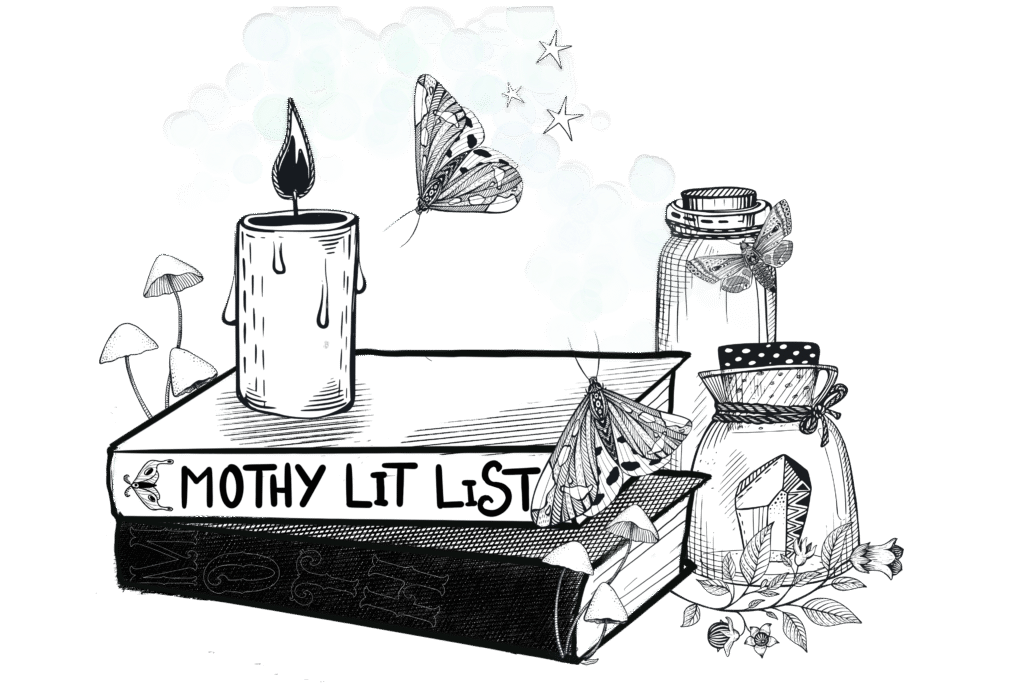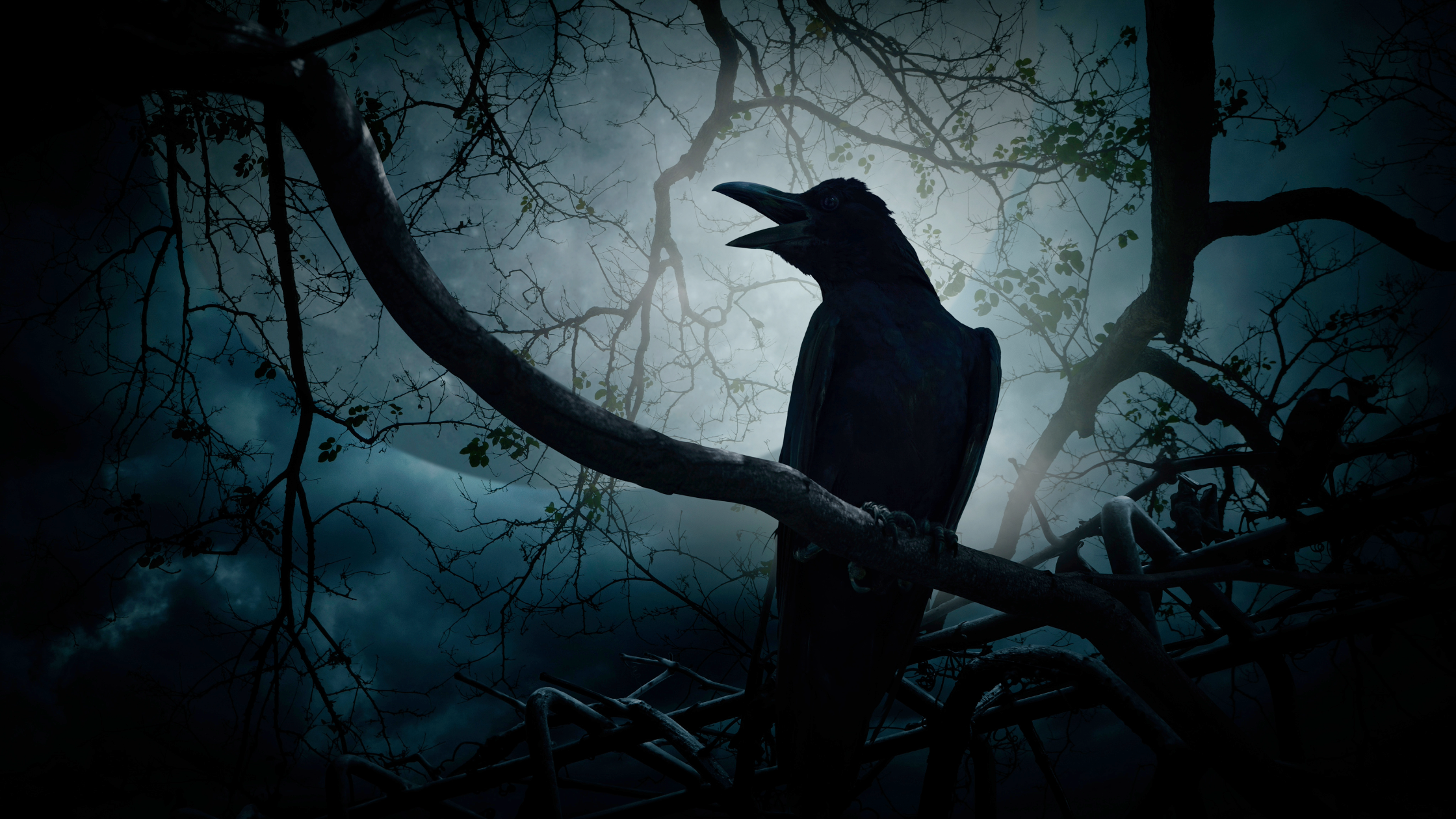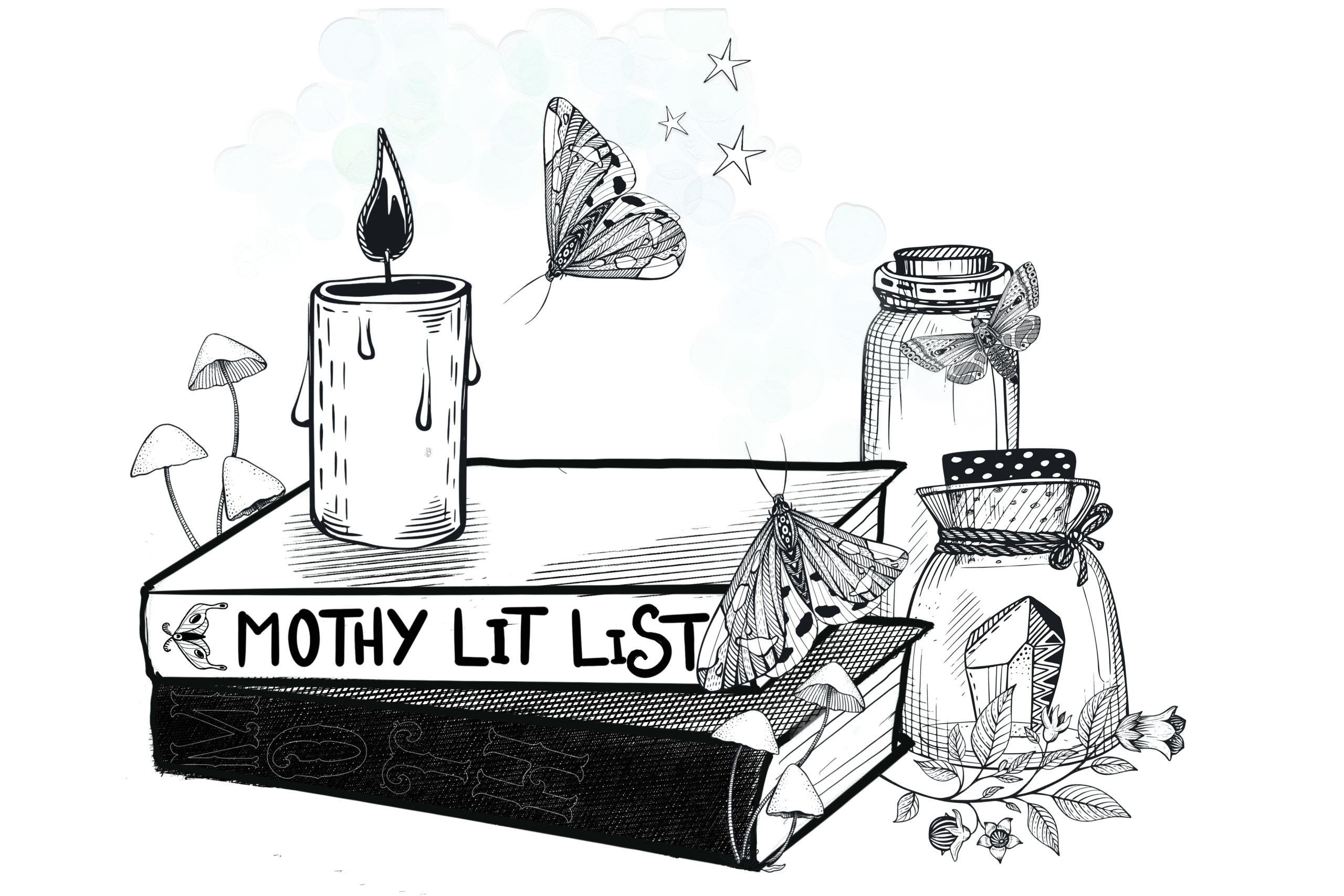Mothing 101: Moths in Literature
Welcome (or welcome back) to Mothing 101, my series of shallow dives into the rabbit hole of moth-related topics for the moth-curious. In this installment, I’m talking about moths in literature. In previous installments, I covered folklore and moth symbolism, so this is more like a semi-annotated reading list.
I wanted to go beyond the cliché of moths drawn to a flame because… meh.
Honestly, I thought this would be an easy article. Spoiler: it wasn’t.
So what follows is a curated list of mothy literature—some I’ve read, some still on my TBR, and some that are fascinating to know about even if they’re not quite my cup of tea. There’s a very wide range in genre and time periods. So, grab a hot drink and cocoon yourself in blankets (or sprawl under the aircon with an icy bevy) and let your reading list transformation begin (Yay! Mothy metaphors!).
My List Criteria
- Moths need to be a strong motif or character, but the work doesn’t have to be only about moths.
- If it was just “moth to a flame,” I skipped it.
- Should be more than a fleeting metaphor in the work.
- Could be any genre I was interested in.
- Moths, not butterflies.
- No movies—because I want to save Mothra and Crimson Peak for another post.
Other Notes
- There is no particular order to this list
- The Mothymeter: my arbitrary decision on how mothy the work. Scale: how many “flutters” out of five.
- Status: Some books I’ve read, and some are on a TBR, and some are just on this list (READ, TBR, LIST).
- Get ready for rabbit holes!
Mothing 101’s Mothy Lit List
1. “The Moth” by H.G. Wells (1895)
Genre: Short story, science fiction (-ish)
Synopsis: A short story by the OG sci-fi writer. The rivalry of two entomologists takes a strange turn when one of them dies and the other believes a moth is the spirit of his rival returned to torment him.
Mothymeter: 4/5 flutters 🦋🦋🦋🦋 (High moth content, high moth metaphor)
Status: READ (listened to via Librivox)
Comments: MC deserved his fate.
Link: Audio on LibriVox
2. “The Lady of the House of Love” in The Bloody Chamber by Angela Carter (1979)
Genre: Magical realism, fairytale/folktale inspired
Synopsis: A young British soldier stumbles upon a mysterious, decaying castle in Eastern Europe, inhabited by a beautiful, tragic vampire Countess. Mothy content: uses imagery of the Death’s-Head Hawkmoth to evoke themes of mortality and the macabre.
Mothymeter: TBD
Status: TBR
LINK: Angela Carter on Goodreads
Fun Fact: Loosely based on Sleeping Beauty and Carter’s BBC radio play called Vampirella.
3. The Moth Saga by Daniel Arenson (2013-2014)
Genre: Fantasy
Synopsis: A series of fantasy novels where moth imagery is part of the world building. Planet has an orbit where only one side receives light.
Mothymeter: TBD
Status: LIST
LINK: Daniel Arenson’s website
Comments: This book keeps popping up on my searches for mothy lit but I’m not sure if I’m into it. Let me know if I need to put it on the TBR.
4. Akata Witch by Nnedi Okorafor (2011)
Genre: Fantasy, Young Adult (book 1 of 3 book series)
Synopsis: Sunny, an American-born girl living in Nigeria, discovers she has magical abilities linked to her heritage. She joins a secret society of magical students and must navigate spells, curses, and shadowy forces threatening her world. Moths appear throughout the story as part of the magical lore, symbolizing mystery, transformation, and the hidden connections between the spirit and human worlds.
Mothymeter: TBD
Status: TBR
LINK: Akata Witch on Nnedi Okorafor’s website
Comments: Moths appear as part of the magic. I’ve had this on my TBR for so long that I’m bumping it to the top.
5. The Moth by Ouida (Maria Louise Ramé) (1880)
Genre: Fiction
Synopsis: Published in 1880, uses “moth drawn to doom” metaphor. Technically, this dances on the edge of breaking criteria 2 by describing a woman’s attraction to high society. Main character described as fragile like a moth.
Mothymeter: Technically TBD but 2/5 flutters 🦋🦋 (Low moth content, some moth metaphor, but very interesting author)
Status: TBR
Links: The Moth (Internet Archive)
Rabbit Hole Alert:
Ouida (Maria Louise Ramé 1839-1908), contemporary of Oscar Wilde and Wilkie Collins, supported herself from her work. Encyclopedia Britannica calls her a “Victorian novelist, animal rights activist.”
Ouida wrote in a wide variety of genres, from children’s stories (A Dog of Flanders) to the more ‘scintillating’ tales of Victorian high society. When she writes about the scandalous events of her contemporary world, you could consider her the Victorian, language-coded Jackie Collins of her time. She lived extravagantly, hosted literary salons, and supposedly based many characters on salon guests.
Sadly, she died in poverty because she spent her money lavishly when she had it. But I love the creative energy of her life and that she supported herself through her creative endeavors. I would also consider her potentially the Victorian version of the multi-passionate creativepreneur.
While researching Ouida, I discovered this gem of a podcast: Lost Ladies of Lit Podcast Transcript. Find out more about Ouida and other Lost Ladies of Lit.
6. The Moth Diaries by Rachel Klein (2002)
Genre: YA, Gothic
Synopsis: Modern Gothic novel using moth metaphor to explore adolescence, obsession, and mental illness.
Mothymeter: TBD
Status: LIST
LINK: The Moth Diaries on Goodreads
Comments: A movie was made from this book and maybe I’ll watch that instead.
7. Mothlight by Adam Scovell (2019)
Genre: Folklore/Modern lit/horror? (not sure)
Synopsis: A novel blending horror and folklore, where moths serve as symbols of transformation and spiritual revelation. A boy becomes interested in moths through his older lepidopterist friend, and when she dies, goes through her belongings to find out her mysteries.
Mothymeter: TBD
Status: TBR
LINKS: Mothlight on Goodreads
Comments: I’m interested in this book. I’m either going to love it or DNF immediately. It’s giving shades of Possession by A. S. Byatt but I’m not sure how accurate that comparison is.
8. The Language of Moths by Christopher Barzak (2005)
Genre: Magical realism, fantasy
Synopsis: Father takes family to the mountains to hunt a moth. Boy discovers his autistic sister can talk to insects. Coming-of-age story.
Fun Fact: Finalist for Nebula Award in 2007 (novelette)
Mothymeter: TBD
Status: LIST
LINKS: Before and Afterlives on Barzak’s website | Audiobook
Comments: This novella is found in the collection Before and Afterlives. The audiobook is the novella only.
This reminds me too much of when my dad was interested in gold panning and we all had to spend weekends camping in the forest. Though the sister speaking the language of moths is fascinating.
9. Moths by Jane Hennigan (2021)
Genre: Post-apocalyptic sci-fi
Synopsis: Toxic threads left by mutated moths infect men and boys around the globe.
Mothymeter: TBD
Status: LIST
LINK: Jane Hennigan’s website
Comments: There are so many concepts in this book that interest me, but I’m in no frame of mind to read post-apocalyptic anything right now.
10. “The Death of the Moth” by Virginia Woolf (1942)
Genre: Essay
Mothymeter: 1/5 flutters 🦋
Synopsis: Essay uses a moth’s death as a metaphor for life, energy, and the inevitability of death.
Link: Read online (This is a Gutenberg.au link. Availability may vary by region).
Comments: I’m not a Virginia Woolf fan. I’ve never finished To the Lighthouse. Every time I’ve tried, it feels the same way as when I was anesthetized for surgery. Decided to try “Death of a Moth” because moths are more intriguing than lighthouses.
ONE HOUR LATER:
Read it without falling asleep. Still not a fan. Basically, she let a moth die by beating against glass to make a metaphor about life. Ugh.
Okay. I can’t say she absolutely let the moth die, or just said she did for a literary device. Creative non-fiction? Still not my favorite essay. Discovered I don’t enjoy meditations on the futility of life. Let the moth out. Go live life.
11. The Moth Keeper (Graphic Novel) by K. O’Neill (2023)
Genre: Graphic novel, middle-grade fantasy
Synopsis: Gorgeous art, actual moths, moth metaphors. Being a Moth Keeper is a huge responsibility. What happens when the new keeper takes a break from the moon to see the sun for the first time? Middle-grade fantasy about passion, duty, and found family.
Mothymeter: 5/5 flutters 🦋🦋🦋🦋🦋
Status: Currently Reading
LINK: The Mothkeeper on Goodreads
12. Me (Moth) by Amber McBride (2021)
Genre: YA, Novel-in-Verse, Magical Realism
Synopsis: A Black teen girl nicknamed Moth struggles to find her way after losing her family in a tragic accident. On a transformative road trip with Sani, a boy exploring his own roots, Moth confronts grief, discovers ancestral connections, and learns the power of resilience. Moth symbolism provides a metaphor for transformation, identity, and healing.
Mothymeter: TBD (but sounds very promising!)
Status: TBR
Fun Fact / Comment: This is Amber McBride’s debut novel and was a finalist for the 2021 National Book Award for Young People’s Literature. The story blends Black, Southern hoodoo traditions with Navajo/Diné spirituality which is really interesting.
Links: Amber McBride’s website | More about Amber McBride
13. The Moth Girl by Heather Kamins (2022)
Genre: YA
Synopsis: Teen girl diagnosed with illness that manifests as moth-like traits (lepidopsy). Explores living with chronic illness through fantasy.
Mothymeter: TBD
Status: TBR
LINK: Heather Kamins’s website
14. “The Moths” by Mary Oliver (1984)
Genre: Poetry
Synopsis: Less about moths literally; moths serve as catalysts to notice the world, highlighting the pain of awareness.
Link: Poetry Foundation
Mothymeter: 3/5 flutters 🦋🦋🦋
Status: Read
Comments: Too thematically close to Virginia Woolf.
15. Flare: A Cryptid Desires Novella by K.T. Maddan (2024)
Genre: Monster romance
Synopsis: Features Mothman in a romance novel. Trigger warnings for human-monster sexual content.
Links: Amazon
Mothymeter: TBD
Status: TBR (Definitely!)
Comments: Giving new meaning to moth curious?
16. “The Moth and the Star” by James Thurber in The New Yorker (1939) , Fables of Our Time (1940)
Genre: short story/ modern fable
Synopsis: A moth dreams of flying to a star while his family tries to convince him to be like other moths and fly towards streetlamps. Our mothy hero sticks to his dreams and lives his own mothy life, thus avoiding the lamp-light deaths of his brethren. And in his mothy old age, he tells everyone he made it to the star, which was just a more distant streetlamp.
Link: Read In The New Yorker Archives
Mothymeter: 5/5 flutters 🦋🦋🦋🦋🦋
Status: Read
Comments: There are a couple of great lessons from this story that still apply today: giving up dreams in favor of conformity isn’t advantageous; the survivors get to (re)write the history of their life.
17. Empire of the Damned by Jay Kristoff (2024)
Genre: Fantasy / Vampire
Synopsis: Second book in the series Empire of the Vampire. Before his execution, Gabriel, last of the vampire hunters (called Silversaints), tells his vampire captors about his adventures while trying to return daylight to the world. The moth content is about one character which transforms into a moth.
Mothymeter: 7/5 flutters 🦋🦋🦋🦋🦋🦋🦋
Status: Read
LINK: Empire of the Damned on Jay Kristoff’s website
Comments: I know the mothymeter only goes to 5, but I love this book. And the moth character is a brilliant idea.
Time to flutter off and read my pretties
Whether you’re reading for moths as metaphor, character, or pure fascination, I hope this list sparks curiosity and adds some flutter to your reading list. Do you agree with my ratings? Know a mothy gem I missed? Share it in the comments! I’d love to create a second list or make amendments based on your suggestions!

If you are a moth fan, you can read more of my mothy content from the Mothing 101 series.
Credits: Some elements of the image from Magic Vector by Mollyart.


